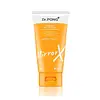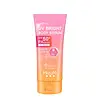What's inside
What's inside
 Key Ingredients
Key Ingredients

 Benefits
Benefits

 Concerns
Concerns

 Ingredients Side-by-side
Ingredients Side-by-side

Water
Skin ConditioningCyclopentasiloxane
EmollientNiacinamide
SmoothingMethylene Bis-Benzotriazolyl Tetramethylbutylphenol
UV FilterPropylene Glycol
HumectantCaprylic/Capric Triglyceride
MaskingTitanium Dioxide
Cosmetic ColorantZinc Oxide
Cosmetic ColorantPotassium Azeloyl Diglycinate
Skin ConditioningDiethylhexyl Carbonate
EmollientAlpha-Arbutin
AntioxidantGlutathione
Polyglyceryl-4 Diisostearate/Polyhydroxystearate/Sebacate
EmulsifyingPEG-10 Dimethicone
Skin ConditioningCetyl PEG/PPG-10/1 Dimethicone
EmulsifyingTriethoxycaprylylsilane
Aluminum Hydroxide
EmollientGlycine Soja Seed Extract
Skin ConditioningTocopheryl Acetate
AntioxidantWater, Cyclopentasiloxane, Niacinamide, Methylene Bis-Benzotriazolyl Tetramethylbutylphenol, Propylene Glycol, Caprylic/Capric Triglyceride, Titanium Dioxide, Zinc Oxide, Potassium Azeloyl Diglycinate, Diethylhexyl Carbonate, Alpha-Arbutin, Glutathione, Polyglyceryl-4 Diisostearate/Polyhydroxystearate/Sebacate, PEG-10 Dimethicone, Cetyl PEG/PPG-10/1 Dimethicone, Triethoxycaprylylsilane, Aluminum Hydroxide, Glycine Soja Seed Extract, Tocopheryl Acetate
Water
Skin ConditioningOctocrylene
UV AbsorberPropylene Glycol
HumectantEthylhexyl Salicylate
UV AbsorberButyl Methoxydibenzoylmethane
UV AbsorberIsohexadecane
EmollientC12-15 Alkyl Benzoate
AntimicrobialDipropylene Glycol
HumectantDicaprylyl Carbonate
EmollientNiacinamide
SmoothingPhenoxyethanol
PreservativeCetearyl Alcohol
EmollientGlyceryl Stearate
EmollientMethyl Methacrylate
Methyl Methacrylate Crosspolymer
PEG-100 Stearate
Titanium Dioxide
Cosmetic ColorantPotassium Cetyl Phosphate
EmulsifyingPolyacrylamide
Parfum
MaskingC13-14 Isoparaffin
EmollientChlorphenesin
AntimicrobialDisodium EDTA
Acrylates/C10-30 Alkyl Acrylate Crosspolymer
Emulsion StabilisingSodium Hydroxide
BufferingCarbomer
Emulsion StabilisingLaureth-7
Emulsifying1,2-Hexanediol
Skin ConditioningTocopheryl Acetate
AntioxidantGlycerin
HumectantBiosaccharide Gum-4
Skin ConditioningButylene Glycol
HumectantTocopherol
AntioxidantTerminalia Ferdinandiana Fruit Extract
AntioxidantOryza Sativa Lees Extract
Skin ConditioningPrunus Lannesiana Flower Extract
Skin ConditioningWater, Octocrylene, Propylene Glycol, Ethylhexyl Salicylate, Butyl Methoxydibenzoylmethane, Isohexadecane, C12-15 Alkyl Benzoate, Dipropylene Glycol, Dicaprylyl Carbonate, Niacinamide, Phenoxyethanol, Cetearyl Alcohol, Glyceryl Stearate, Methyl Methacrylate, Methyl Methacrylate Crosspolymer, PEG-100 Stearate, Titanium Dioxide, Potassium Cetyl Phosphate, Polyacrylamide, Parfum, C13-14 Isoparaffin, Chlorphenesin, Disodium EDTA, Acrylates/C10-30 Alkyl Acrylate Crosspolymer, Sodium Hydroxide, Carbomer, Laureth-7, 1,2-Hexanediol, Tocopheryl Acetate, Glycerin, Biosaccharide Gum-4, Butylene Glycol, Tocopherol, Terminalia Ferdinandiana Fruit Extract, Oryza Sativa Lees Extract, Prunus Lannesiana Flower Extract
Ingredients Explained
These ingredients are found in both products.
Ingredients higher up in an ingredient list are typically present in a larger amount.
Niacinamide is a multitasking form of vitamin B3 that strengthens the skin barrier, reduces pores and dark spots, regulates oil, and improves signs of aging.
And the best part? It's gentle and well-tolerated by most skin types, including sensitive and reactive skin.
You might have heard of "niacin flush", or the reddening of skin that causes itchiness. Niacinamide has not been found to cause this.
In very rare cases, some individuals may not be able to tolerate niacinamide at all or experience an allergic reaction to it.
If you are experiencing flaking, irritation, and dryness with this ingredient, be sure to double check all your products as this ingredient can be found in all categories of skincare.
When incorporating niacinamide into your routine, look out for concentration amounts. Typically, 5% niacinamide provides benefits such as fading dark spots. However, if you have sensitive skin, it is better to begin with a smaller concentration.
When you apply niacinamide to your skin, your body converts it into nicotinamide adenine dinucleotide (NAD). NAD is an essential coenzyme that is already found in your cells as "fuel" and powers countless biological processes.
In your skin, NAD helps repair cell damage, produce new healthy cells, support collagen production, strengthen the skin barrier, and fight environmental stressors (like UV and pollution).
Our natural NAD levels start to decline with age, leading to slower skin repair, visible aging, and a weaker skin barrier. By providing your skin niacinamide, you're recharging your skin's NAD levels. This leads to stronger, healthier, and younger looking skin.
Another name for vitamin B3 is nicotinamide. This vitamin is water-soluble and our bodies don't store it. We obtain Vitamin B3 from either food or skincare. Meat, fish, wheat, yeast, and leafy greens contain vitamin B3.
The type of niacinamide used in skincare is synthetically created.
Learn more about NiacinamidePropylene Glycol is an odorless, colorless liquid. As a humectant, it helps skin retain moisture. It also aids in delivering active ingredients.
Another role of this ingredient is preventing a product from melting or freezing. Propylene glycol also adds antimicrobrial properties to a product, elongating product lifespan.
This ingredient is considered an organic alcohol and commonly added into both cosmetics and foods.
Those with sensitive skin or conditions may develop a rash when using this ingredient.
Learn more about Propylene GlycolTitanium dioxide is a mineral UV filter widely used in sunscreens and cosmetics.
It is one of only two UV filters officially classified as “mineral” by regulatory agencies, the other being zinc oxide.
Titanium dioxide provides broad-spectrum protection mostly in the UVB and UVAII range, with some protection in the UVAI range.
While its UVA protection isn’t as strong as zinc oxide’s, the difference is minor.
A common myth is that mineral UV filters reflect UV light. However, modern research shows titanium dioxide absorbs UV radiation like chemical filters (~95% absorption & 5% reflection).
Thanks to its non-irritating nature, titanium dioxide is suitable for sensitive, acne-prone, or redness-prone skin. It is unlikely to cause "eye sting" like other sunscreen ingredients.
A major drawback of this ingredient is its white cast and thick texture. This is why mineral sunscreens often leave a white cast and are less cosmetically elegant than chemical/hybrid sunscreens.
To improve white cast and spreadability, micronized or nano-sized titanium dioxide is often used.
There are ongoing concerns surrounding nano-titanium oxide's impact on marine ecosystems.
There is no conclusive evidence that any form of titanium oxide (or any other sunscreen ingredients) will cause harm to marine ecosystems or coral reefs. The science is still developing but many consumers are keeping a close eye on this issue.
Please note, many destinations have reef-safety sunscreen rules. For instance, the U.S. Virgin Islands advises all visitors to use non-nano mineral sunscreens.
Nano mineral sunscreens once raised safety concerns about absorption into skin.
Extensive research has shown that they do not penetrate healthy or damaged skin; they remain safely on the surface and the top layer of dead skin (stratum corneum).
You'll likely find titanium dioxide bundled with alumina, silica, or dimethicone. These ingredients help make titanium dioxide highly photostable; this prevents it from interacting with other formula components under UV light.
Learn more about Titanium DioxideTocopheryl Acetate is AKA Vitamin E. It is an antioxidant and protects your skin from free radicals. Free radicals damage the skin by breaking down collagen.
One study found using Tocopheryl Acetate with Vitamin C decreased the number of sunburned cells.
Tocopheryl Acetate is commonly found in both skincare and dietary supplements.
Learn more about Tocopheryl AcetateWater. It's the most common cosmetic ingredient of all. You'll usually see it at the top of ingredient lists, meaning that it makes up the largest part of the product.
So why is it so popular? Water most often acts as a solvent - this means that it helps dissolve other ingredients into the formulation.
You'll also recognize water as that liquid we all need to stay alive. If you see this, drink a glass of water. Stay hydrated!
Learn more about Water